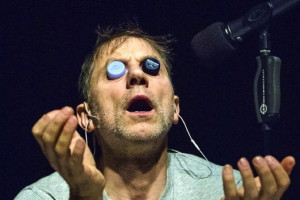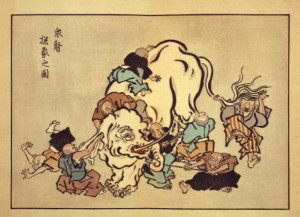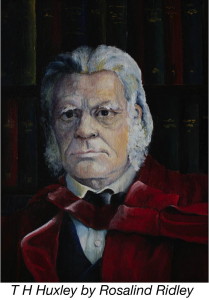Over the last couple of years, Uta & I have been meeting with Simon McBurney, director of Complicite as he prepared for his one-man show, The Encounter. Simon hoped that we might be able to tell him what neuroscience can reveal about the nature of consciousness.
The Encounter dramatizes the experiences of Loren McIntyre, as described in Amazon Beaming by Petru Popescu. When Simon told us about this book it was long out of print, but we managed to find a second hand copy. As a result of Simon’s work it was republished in 2015.
Loren McIntyre was a National Geographic photographer, and this is the story about his experiences when he was lost in the remote Amazon rain forest. His survival depends on the leader of a small group of Mayoruna people who he has followed into the jungle and then become hopelessly lost. But there is no common language through which they can communicate. He feels utterly isolated with ‘a psychological distance of 20,000 years’ between him and the people who are his only hope finding a way back. Eventually he starts to experience ‘communication’ from the leader of the group when he sits near him. He begins to understand some puzzling behaviour, for example, why the group keep destroying their villages and moving on. Remarkably, this communication doesn’t depend on language.
 In The Encounter everyone in the audience wears earphones, which helps Simon to recreate and share all the strangeness and terror of McIntyre’s experiences through the wonder of acoustic technology.
In The Encounter everyone in the audience wears earphones, which helps Simon to recreate and share all the strangeness and terror of McIntyre’s experiences through the wonder of acoustic technology.
When we first talked to Simon about the work he was developing around Amazon Beaming, he asked us whether we thought it was possible for two people to communicate without words. We said, absolutely.
And here is why.
Communication is not simply about the transfer of information. You can do that with a cash machine. When we communicate we know that we are communicating, and we know that our partner knows that she is communicating. We have a subjective, conscious experience of communicating. This experience, we hypothesise, predates language.
This is what I would have said in a discussion planned after a performance of The Encounter at the Barbican. Unfortunately I couldn’t be there because I had to have an operation for a detached retina.
What is conscious experience?
When I look out into the audience, I am aware of innumerable faces. I have the subjective experience of seeing many faces. But this is an illusion. I don’t mean that you are all figments of my imagination. I am confident you are all out there, but, even so, some of you at least are figments of my imagination.
The problem is that my contact with you all seems so direct, when it is really very slight. The only clues I have about you come from the sparse signals that my eyes and ears are sending to my brain. From these crude signals, and from years of experience, my brain can make quite a good model of what’s out there.
 You will remember the story of the blind men who come across an elephant. One feels its trunk and thinks it is a snake, another feels its leg and thinks it is a tree.
You will remember the story of the blind men who come across an elephant. One feels its trunk and thinks it is a snake, another feels its leg and thinks it is a tree.
A single sighted man who comes across an elephant is doing the same thing. The elephant is too big to see with a single fixation of the eye. We have to look all over it. If our eye lands on the trunk, then it’s a good bet that it’s a snake. But, then, as the eye moves along it a head or a tail should appear. When this doesn’t happen, then the model has to be changed. It isn’t a snake. Perhaps it’s an elephant. The more evidence our eyes take in the more plausible it becomes that the thing is an elephant. Our eyes move very fast (4 to 8 fixations per second). Within a few 100 msecs we see the elephant. We are entirely unaware of all the work our brain has done and, of course, what we are seeing is not the elephant, but the model that our brain has constructed. This model is often incomplete with several missing bits that are filled in with guesses. This is why some of you are figments of my imagination. There is a well known youtube video, showing that a gorilla can walk by some basketball players without being noticed, if you are too busy counting the basketball passes.
But what is the point of all this vivid subjective experience?
 TH Huxley believed that our conscious experience has no function: ’Consciousness [is]completely without any power of modifying the working [of the body] as the steam-whistle which accompanies the work of a locomotive engine is without influence upon its machinery.’ I believe that Huxley was wrong and we can see this from the metaphor he chose. This is because the steam-whistle does influence the behaviour of other engines.
TH Huxley believed that our conscious experience has no function: ’Consciousness [is]completely without any power of modifying the working [of the body] as the steam-whistle which accompanies the work of a locomotive engine is without influence upon its machinery.’ I believe that Huxley was wrong and we can see this from the metaphor he chose. This is because the steam-whistle does influence the behaviour of other engines.
Our conscious experience is very vivid, but also very private. There is no way I can have your experiences. It even is possible that the colour experience that I call red is actually the one you would call green if you were to experience it. How could we ever know? But there is a paradox here. Our conscious experience may be private, but it is also the only aspect of our mental life that we can share with others. I can’t tell you anything about what my brain is doing. And I certainly can’t tell you about all those mental processes that never reach my consciousness.
What I can tell you about is my model of the world. And, at the same time, you can be telling me about your model of the world. So if we are like steam locomotives, we are certainly hearing each other’s whistles.
Conscious experience is for interacting
And, because we are sharing the same world and because we also have very similar brains, our models are also likely to be very similar. But they will not be entirely similar. Our models will also depend on all our past experiences including our interactions with others. Our models of the world will be strongly influenced by our cultural background.
But what happens when two people interact? Interacting with another person is different from interacting with a rock. Unlike a rock, the person I am interacting with is creating a model of me at the same time as I am making a model of her. The model I create of you helps me to predict what you are going to do, which also helps me to communicate with you. My model of you will have many different aspects. I will try to discover what sort of person you are. But in my view the most important aspect of you that I am trying to model, is your model of the world. That is the model of the world we are currently sharing.
Because we are sharing the same world, any differences in our models will reflect our different experiences and cultural backgrounds. So, when I know something about your model, I know something about you. But, if I need to communicate with you, then I should try to make my model similar to yours. And, at the same time, you will be trying to make your model similar to mine. Some believe that, if two devices interact while making inferences about each other, then they will eventually converge on the same model.
Language is extremely useful for discovering something about other peoples’ models of the world, but it is not the only way. Simply by watching how someone moves you can learn about how they see and understand the world about them. The more you spend time with someone else, the better you will get at predicting how they are going to move. You won’t know how you do it. It just happens.
To make this prediction you have learned about their model of the world and, inevitably, this has changed your own model. At some point the two models will be in almost perfect synchrony. At this point you will have the conscious experience of what seems like, and, indeed is, wordless communication.


Two things came to mind as I read this very nice article.
First, the psychological gap of 20,000 years may not be so large. I think it was Jared Diamond who pointed out that he had met computer programmers in Port Moresby, the capital of Papua New Guinea, whose grandparents had been born into a ‘stone age’ culture in the isolated highlands of that country completely cut off from outside influence. Whatever cognitive processes are needed to acquire the skills of computer programming, they evolved to solve the problems of survival in a hunter gatherer community.
Second, the model of the outside world that two people share when communicating can be so close that the originator of the idea can no longer be identified. This can lead to cryptomnesia, a word coined by Jung to describe the belief that someone else’s good idea was in fact your own.